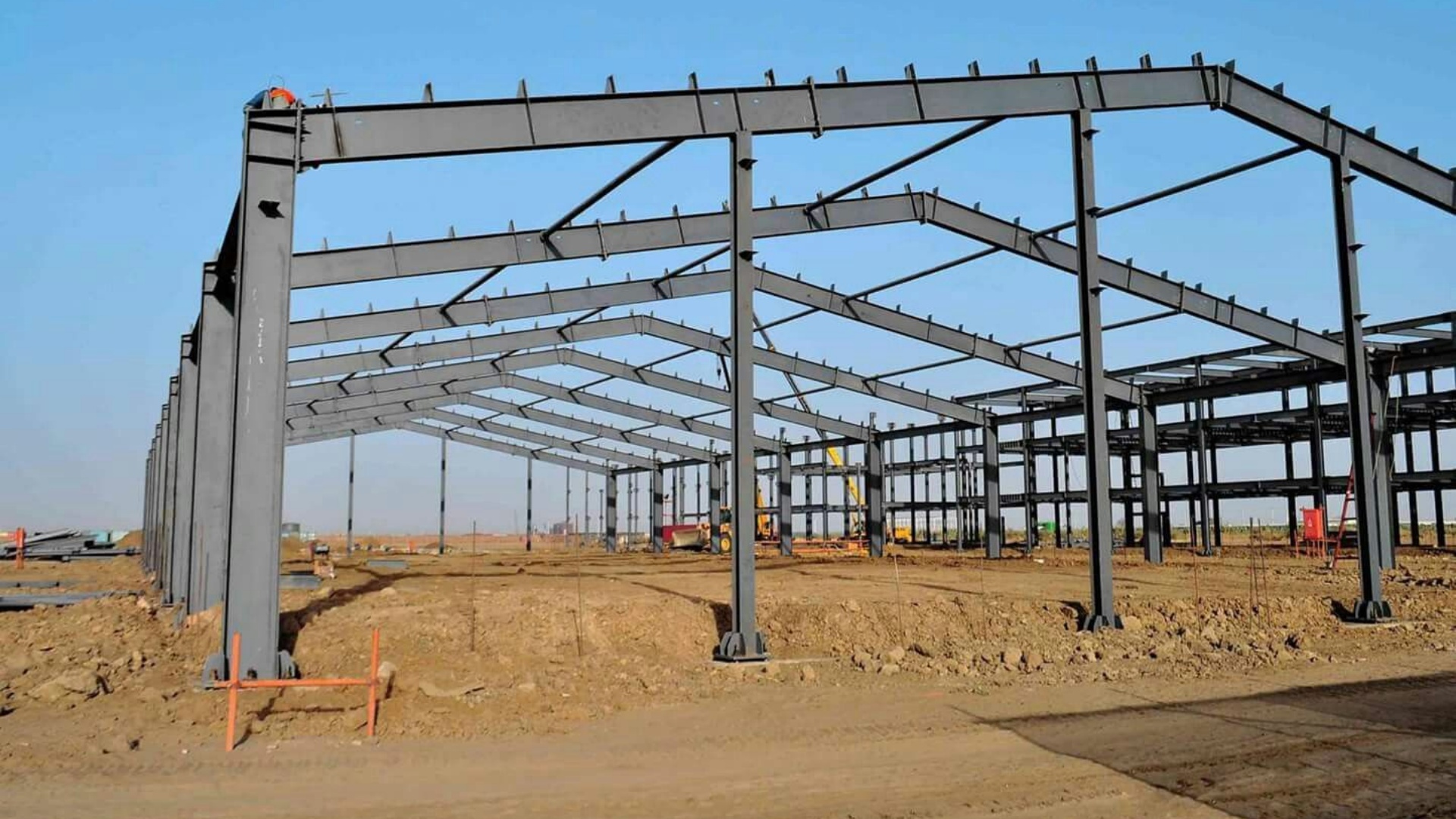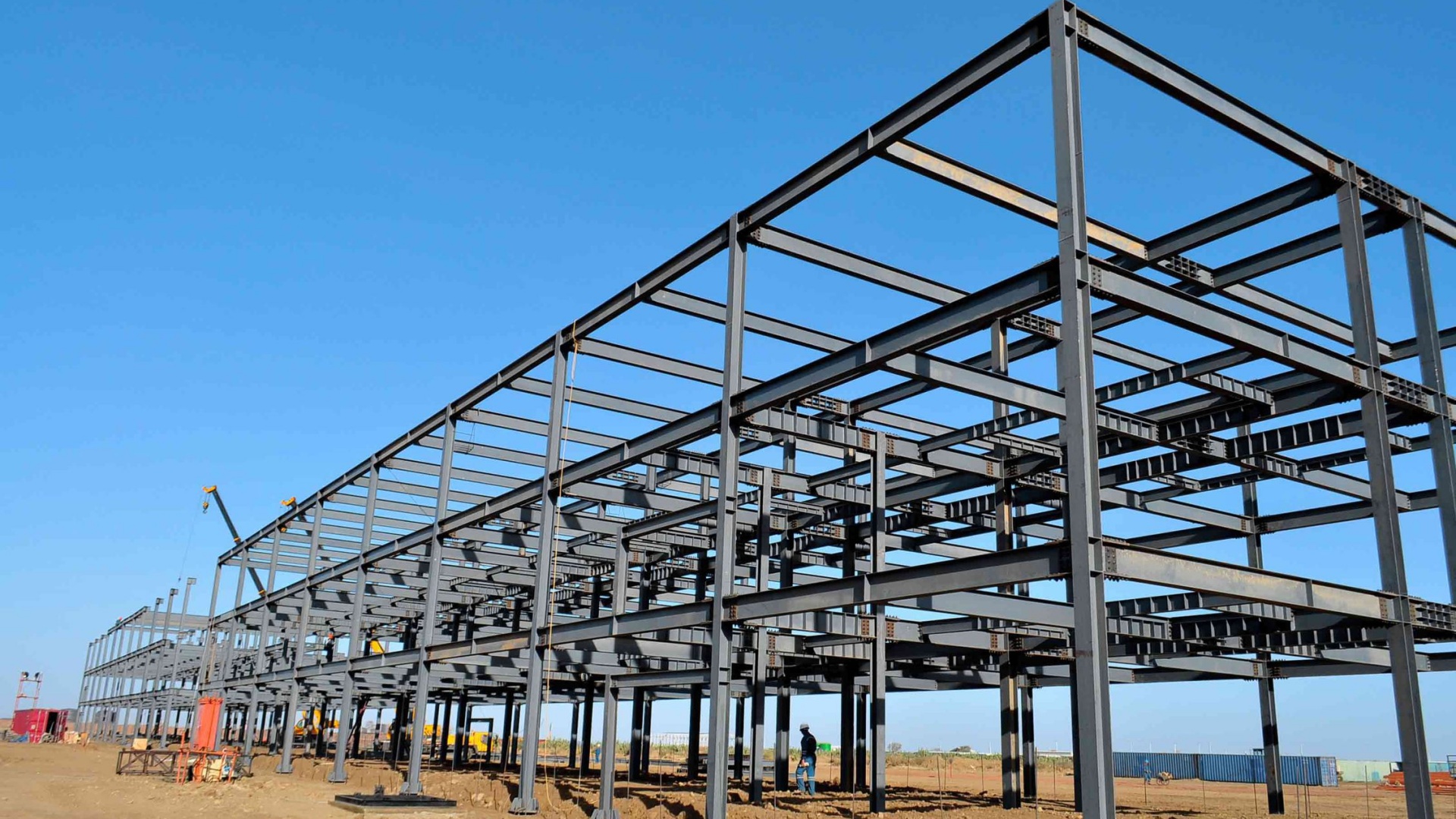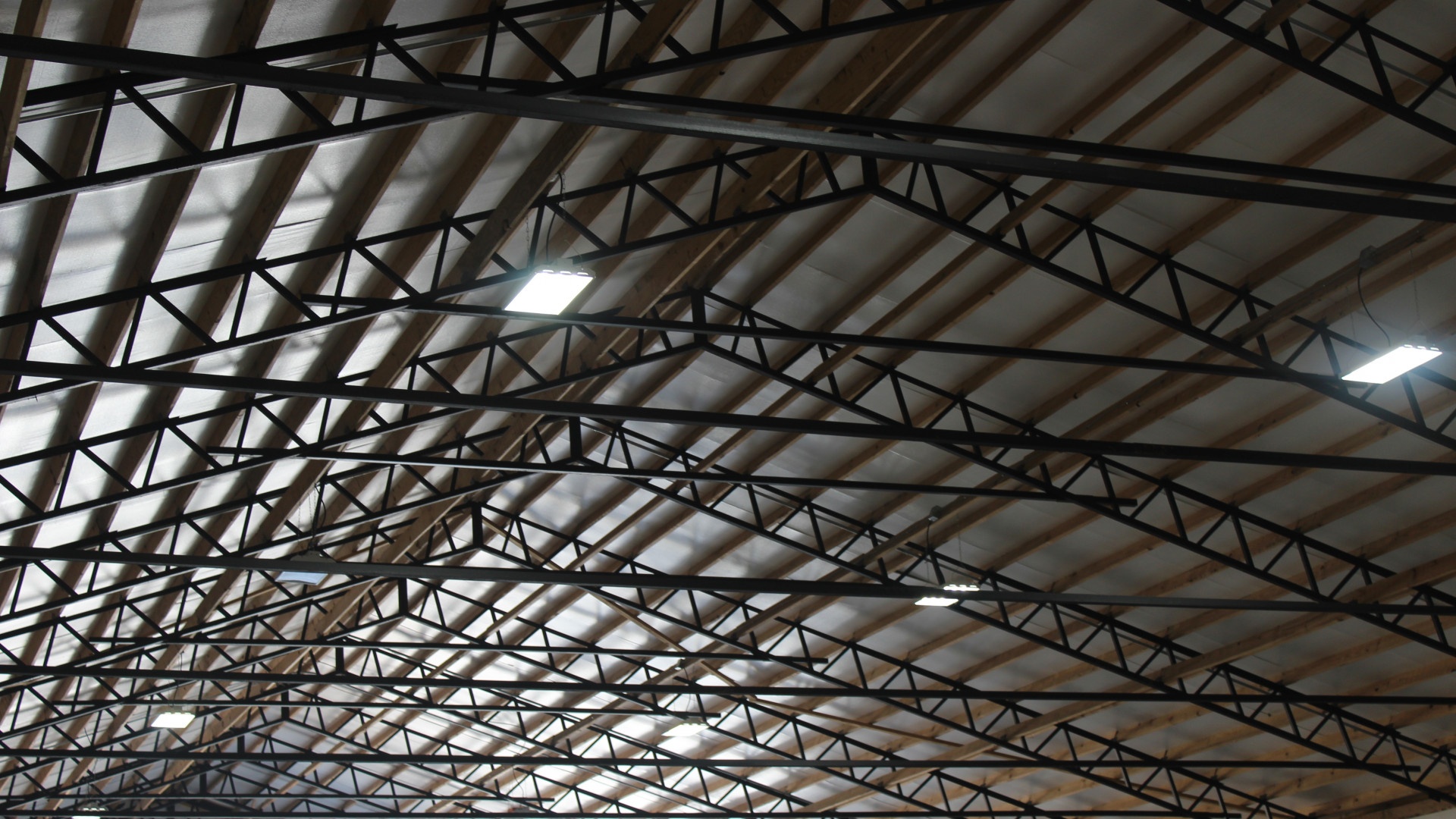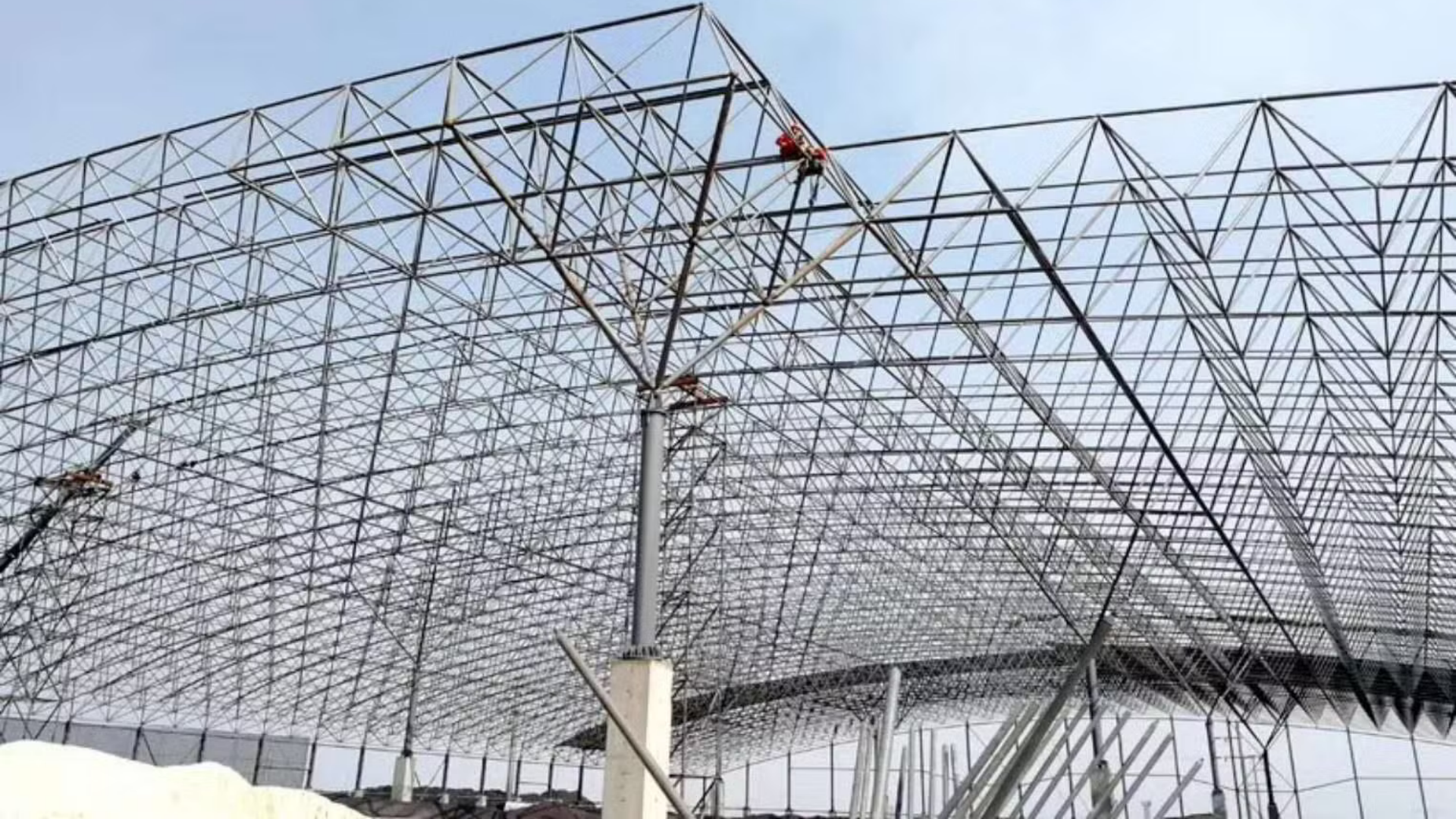Steel structures are widely used in the construction industry due to their advantages, such as high strength, fast construction, and excellent seismic resistance. Different types of steel structures are suitable for different building scenarios, and their base material sizes also vary. Choosing the right steel structure is crucial to building quality and performance. The following details common steel structure types, base material sizes, and key selection points.
Portal Steel Frames
Portal steel frames are flat steel structures composed of steel columns and beams. Their overall design is simple, with well-defined load distribution, offering excellent economical and practical performance. This structure provides a clear load transfer path, effectively bearing both vertical and horizontal loads. It is also easy to construct and install, with a short construction period.
In terms of application, portal steel frames are primarily suitable for low-rise buildings, such as low-rise factories, warehouses, and workshops. These buildings typically require a certain span but not high height. Portal steel frames effectively meet these requirements, providing ample space for production and storage.
Steel Frame
A steel frame is a spatial steel frame structure composed of steel columns and beams. Unlike the flat structure of a portal frame, a steel frame forms a three-dimensional spatial system, offering greater overall stability and lateral resistance. It can be constructed into multi-story or high-rise structures according to architectural requirements, adapting to varying span and height requirements.
Due to its excellent structural performance, steel frames are suitable for buildings with large spans or high heights, such as office buildings, shopping malls, hotels, and conference centers. In these buildings, steel frames not only meet the requirements of large spatial layouts but also facilitate the installation of equipment and the routing of pipelines within the building.
Steel Truss
A steel truss is a spatial structure composed of several individual components (such as angle steel, channel steel, and I-beams) arranged in a specific pattern (e.g., triangular, trapezoidal, or polygonal). Its members primarily bear axial tension or compression, providing a balanced load distribution, fully utilizing the material's strength and saving steel.
Steel trusses have a strong span capacity and are suitable for buildings requiring large spans, such as stadiums, exhibition halls, and airport terminals. In stadiums, steel trusses can create large-span roof structures, meeting the space requirements of auditoriums and competition venues. In exhibition halls and airport terminals, steel trusses provide reliable structural support for spacious display spaces and pedestrian circulation paths.
Steel Grid
A steel grid is a spatial structure composed of multiple members connected by nodes in a specific grid pattern (such as regular triangles, squares, and regular hexagons). It offers advantages such as low spatial forces, excellent seismic resistance, high rigidity, and strong stability. Its single member type facilitates factory production and on-site installation.
Steel grids are primarily suitable for roof or wall structures, such as waiting rooms, canopies, and large factory roofs. In waiting rooms, steel grid roofs can cover large areas, providing a comfortable waiting environment for passengers. In canopies, steel grid structures are lightweight and aesthetically pleasing, while effectively withstanding natural loads such as wind and rain.


- Portal Steel Frames
The steel columns and beams of portal frames are typically constructed from H-shaped steel. The size of these steel columns is determined by factors such as the building's span, height, and load. Generally speaking, for low-rise factories or warehouses with spans of 12-24 meters and heights of 4-6 meters, H-shaped steel columns typically range from H300×150×6.5×9 to H500×200×7×11; beams typically range from H350×175×7×11 to H600×200×8×12. In some cases with lower loads, I-shaped steel or channel steel may be used as auxiliary components. I-shaped steel is typically sized from I14 to I28, while channel steel is typically sized from [12 to [20].
- Steel Frames
Steel frames primarily utilize H-section steel for their columns and beams. Because they must withstand greater vertical and horizontal loads, and because they require greater building height and span, their base material dimensions are typically larger than those of portal frames. For multi-story office buildings or shopping malls (3-6 stories, spans 8-15m), H-section steel dimensions commonly used for columns range from H400×200×8×13 to H800×300×10×16; H-section steel dimensions commonly used for beams range from H450×200×9×14 to H700×300×10×16. In high-rise steel-frame buildings (over 6 stories), columns may utilize welded H-section steel or box-section steel. Box-section steel dimensions typically range from 400×400×12×12 to 800×800×20×20 to improve the structure's lateral resistance and overall stability.
- Steel Trusses
Common base materials for steel truss members include angle steel, channel steel, I-beams, and steel pipes. Angle steel is widely used in steel trusses due to its diverse cross-sectional shapes and easy connection. Common sizes range from ∠50×5 to ∠125×10. For members subject to high loads, channel steel or I-beams are used. Channel steel sizes range from [14 to [30, and I-beam sizes range from I16 to I40.) In long-span steel trusses (spans exceeding 30m), steel pipes are often used as members to reduce structural deadweight and improve seismic performance. The diameter of the steel pipes generally ranges from Φ89×4 to Φ219×8, and the material is usually Q345B or Q235B.
- Steel Grid
Steel grid members are primarily constructed of steel pipes, commonly made of Q235B and Q345B. The pipe size is determined by the grid span, grid size, and load conditions. For grid structures with spans of 15-30m (such as small and medium-sized waiting halls and canopies), the typical steel pipe diameter is Φ48×3.5 to Φ114×4.5. For spans exceeding 30m (such as large stadium roofs and airport terminal roofs), the steel pipe diameter increases accordingly, typically to Φ114×4.5 to Φ168×6. Grid joints are typically bolted or welded ball joints. The diameter of the bolted ball joint is determined by the number of members and the load capacity, typically ranging from Φ100 to Φ300.


Clarify Building Requirements and Usage Scenario
Before purchasing a steel structure, you must first clarify the building's purpose, span, height, number of floors, and environmental conditions (such as seismic intensity, wind pressure, and snow load). Different usage scenarios require different performance from steel structures. For example, in earthquake-prone areas, steel grid or steel frame structures with good seismic resistance should be preferred. For large-span stadiums, steel trusses or steel grids are more suitable. Furthermore, the load-bearing capacity of the steel structure should be determined based on the building's load conditions (such as dead loads and live loads) to ensure that the selected steel structure meets the building's usage requirements.
Examining Steel Quality and Performance
Steel is the core base material of steel structures, and its quality and performance directly impact the safety and durability of the steel structure. When purchasing steel, choose products produced by reputable manufacturers with certified quality assurance. Pay special attention to the steel's material quality (such as Q235B, Q345B, etc.), mechanical properties (such as yield strength, tensile strength, and elongation), and chemical composition. The performance of different steel grades varies significantly. Q345B steel has higher strength than Q235B and is suitable for structures requiring higher load-bearing capacity. Q235B steel, on the other hand, has better plasticity and toughness and is suitable for structures with certain seismic requirements. Additionally, check the steel's appearance to avoid defects such as cracks, inclusions, and bends.
Royal Steel Group specializes in the design and materials of steel structures. We supply steel structures to numerous countries and regions, including Saudi Arabia, Canada, and Guatemala. We welcome inquiries from both new and existing customers.
Address
Kangsheng development industry zone,
Wuqing district, Tianjin city, China.
Hours
Monday-Sunday: 24-hour Service
Post time: Oct-14-2025

